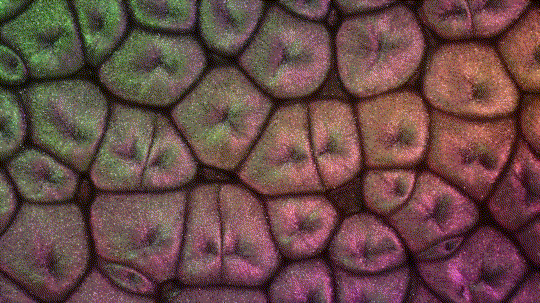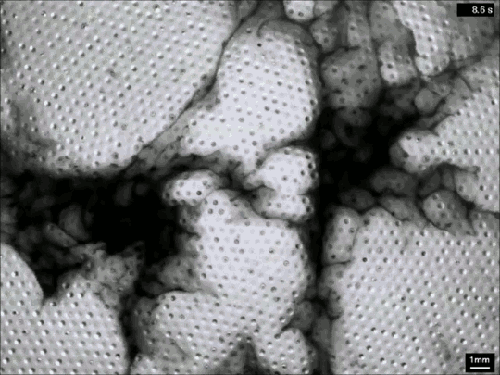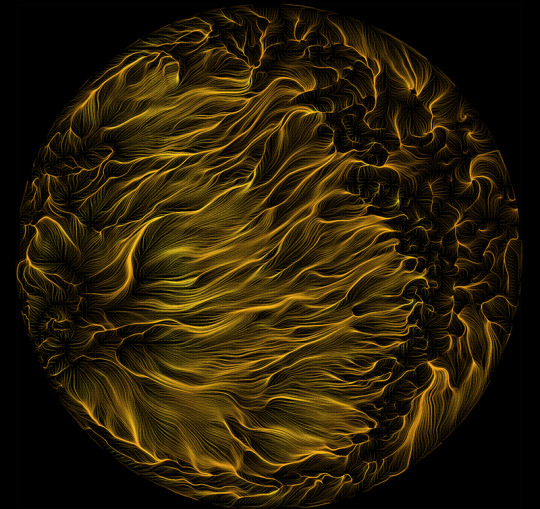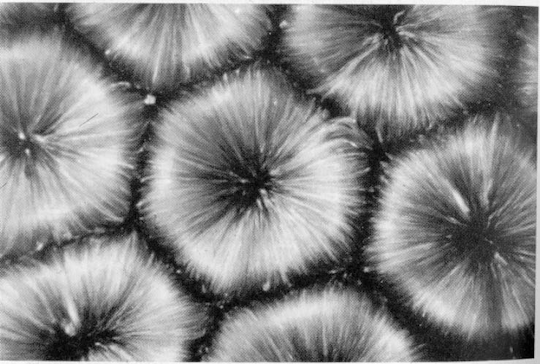#Rayleigh-Benard convection
Text
Turbulent Thermal Convection

In the winter, warm air rises from our floor vents or radiators, creating a complex, invisible flow in the background of our lives. Buoyancy lifts warmer air upward while cooler, denser air sinks back down. This thermal convection is everywhere: in our buildings, the ocean, the sky overhead -- even in the visible layer of our sun. (Image credit: A. Blass; research credit: D. Lohse and O. Shishkina in Physics Today)
Read the full article
#flow visualization#fluid dynamics#instability#physics#Rayleigh-Benard convection#science#thermal convection#turbulence
64 notes
·
View notes
Text
カラビ - ヤウ多様体で量子の狂乱を解消するアイデア2022
The recent completion of the proof of the Poincaré Conjecture has turned the 3-dimensional torus from a strong candidate to a definite matter as the structure of the confirmed universe.
最近のポアンカレ予想の証明完了で確定したユニバースの構造として、3次元トーラスが有力な候補から確定事項に変わりました。
In other words, the structure of the Universe is not spherical, but in the form of a 3-dimensional torus!
つまり、ユニバースの構造とは、球状ではなく、3次元トーラスの形をしていることになります!
As evidence that the proof of the Poincaré Conjecture is theoretically correct, the periodic distribution of quasars was cited.
ポアンカレ予想の証明が、理論上正しいと言うことの証拠として、挙げられたのが、クエーサーの周期的な分布になります。
The Poincaré Conjecture "A single connected 3-dimensional closed polytope is isomorphic to a 3-dimensional sphere" is simple.
ポアンカレ予想「単連結な3次元閉多様体は3次元球面に同相である」という単純なこと。
Extending it to n dimensions, "A mono-connected n-dimensional homotopy sphere is isomorphic to an n-dimensional sphere".
n次元に拡張すると「単連結なn次元ホモトピー球面は、n次元球面に同相である」となります。
William Thurston developed this field in the 1970s.
1970年代にウィリアム・サーストンがこの分野を発展させました。
I briefly explained the Poincaré Conjecture...
簡単に、ポアンカレ予想を説明しましたが・・・
From the 3-dimensional torus, I was inspired by something.
3次元トーラスから、あることがインスピレーションとして閃きました。
We often imagine that when the universe expands in volume based on the Big Bang theory, the volume expands rapidly in a spherical shape...
よくビックバン理論からユニバースが体積拡大をするときに、球状で急激に体積拡大すると言うイメージ図がありますが・・・
In fact, there is a possibility that the volume does not expand spherically, but rather in a Rayleigh-Benard convective shape in a three-dimensional torus shape.
実は、球状に体積拡大するのではなく、3次元トーラス状にレイリー・べナール対流形状で体積拡大していくと言う可能性も。
This will be clarified in the future depending on research.
今後は研究次第によっては明らかになっていくことでしょう。
The central part of the Milky Way Galaxy, including on Earth...
地球上も含む天の川銀河の中心部分も・・・
(下図の形も3次元トーラスになります)

So, as I filled in in "On the Coincidence of Fermi Bubbles and Elementary Particles 2022", I realized that there is another possibility.
ということで「フェルミバブルと素粒子の偶然の一致について2022」でも記入しましたが、別の可能性もあることに気づきました。
What I mean by that is "being able to explain quantum madness in Calabi-Yau manifolds."
どう言うことかと言うと「カラビ - ヤウ多様体で量子の狂乱を説明できること」
We start by explaining black holes and wormholes in superstring theory.
スーパーストリング理論でブラックホールとワームホールを説明することから始めます。
Black holes also provide an intriguing example of the fabric of space being stretched to its limits.
ブラックホールも空間の織物が限界まで引き延ばされると言う興味を抱く例を提供しています。
In a black hole, the enormous gravitational field is known to cause so much extreme curvature in the fabric of space that it is either cut away or punctured at the center of the black hole.
ブラックホールでは、巨大な重力場のせいで、空間の織物に極度の湾曲が生じるあまり、ブラックホールの中心で切り取られるか、穴を開けられるかが知られています。
Unlike wormholes, black holes have solid experimental evidence to support their existence, so the question of what is really going on at the center point is not a guess.
ワームホールの場合と違い、ブラックホールには、その存在を裏付ける確かな実験上の証拠があるので、中心点でほんとに何が起こっているのかと言う問いは推測ではなく
It has become the subject of research around the world as the "Singularity."
「特異点」として世界中の研究対象になっています。
Wormhole is said to be Einstein - Rosenbridge, one of possible structures as topological geometry on spacetime structure.
ワームホールとは、アインシュタイン - ローゼンブリッジと言われていて、時空構造上のトポロジー幾何学として考えうる構造の一つ。
It is considered as a general image that it is a tunnel-like loophole in a space area directly connecting from one spatio temporal point to another distant point, but nobody has experimented, so talk about the hypothesis area.
時空のある一点から別の離れた一点へと直結する空間領域でトンネルではなく抜け道であると一般的なイメージとして考えられているが、誰も実験していないので仮説の域の話。
Although there are many talks to advance the story on the premise that it connects, it is impossible to realize whether it is possible to freely control and maintain the connection to each spot in an open space-time space at the present time. Actually human beings can not pass (because human beings black out due to the impact of sound speed)
つながることを前提として物語を進める話が多いが、開放的な時空間上で、各地点へのつながりを自在にコントロールしたり維持できるかどうかも現時点では実現不可能。実際に人間も通過��きない(音速の衝撃くらいで人間はブラックアウトしてしまうため)
I mean, before we go any further, let's conclude...
つまり、結論を先に言うと・・・
If we pull out a bit at the "inside of the neck" of the Calabi-Yau space and assume that the space causes a mathematical flop transition, like a three-dimensional torus...
カラビ - ヤウ空間の「くびれ内部」のところで少し引き抜き、3次元トーラスのように空間が数学的なフロップ転移を引き起こすと仮定すると・・・
The tightened Calabi-Yau space grows a sphere that connects its surfaces smoothly without tearing, alternating between volumetric expansion and contraction.
締め付けられたカラビ - ヤウ空間が、引き裂かれることなく、その表面を滑らかにつなげる球面が、体積膨張と体積収縮を交互に繰り返しながら成長していく。
Only when a portion of the "flop transition" creates a three-dimensional torus and expands in volume, does it form a wormhole bridge or tunnel, with the upper and lower ends both connected to another space.
「フロップ転移」された一部分が、3次元トーラスを作り、体積膨張する場合に限り、トンネルではなく、ワームホールの橋を形成して上下両端が、共に別の空間へと接続される。
I realized that this mathematical method might suppress and cancel out the infinite divergence that is known as quantum frenzy.
この数学的な方法で、量子の狂乱と言われる無限大の発散を抑え、相殺されるかもしれないことに気づいた。
But where is this quantum frenzy, where is this energy conserved from the law of conservation?
でも、量子の狂乱は、このエネルギーは保存の法則から、どこに保存されるのか?
This is a bit of the wormhole concept I mentioned earlier, but what if the sphere grows as a "quantum entanglement" in the wormhole, but bursts into different spaces at the connected upper and lower ends in the same universe?
これは、先ほど、ワームホール概念を少し書いたが、ワームホールで「量子エンタングルメント」として、球面は成長しつつも、同じユニバース内の接続された上下両端の別の空間にバーストしてしまうとしたら?
Inside the wormhole, with the Calabi-Yau space structure idea I mentioned earlier, energy is conserved and transferred, which also takes into account the Neter's theorem.
ワームホール内部は、先ほどのカラビ - ヤウ空間の構造アイデアで、ネーターの定理も考慮に入れたエネルギーが保存転送されます。
Even if it would be like a mirror in supersymmetry theory, which has been confirmed by CERN in 2022 that supersymmetric particles do not exist? Would it not also be possible to solve the problem?
たとえ、2022年にCERNで超対称性粒子が存在しないことが確定してしまった超対称性理論でいう鏡のようになってしまう?ことも解決できないだろうか?
For reference...
参考として・・・
From Candelas, Horowitz, Strominger, and Edward Whitten, Why? Are there three families of elementary particles? The answer to the question is provided in the following section.
カンデラス、ホロウィッツ、ストロミンジャー、エドワード・ウィッテンから、なぜ?素粒子には3つの族が存在するのか?の答えを提示している。
Each of the holes in the Calabi-Yau portion of space is associated with a family of elementary particles with the lowest string vibration of energy.
空間のカラビ - ヤウ部分にある穴のそれぞれにエネルギーが最低のストリング振動の素粒子の族が結びついています。
Since the familiar elementary particles should correspond to the lowest energy vibration patterns...
お馴染みの素粒子は最低エネルギーの振動パターンに対応するはずなので・・・
The existence of multiple holes, as in the multiple 3D torus holes, also means that the string's vibration pattern is divided into multiple families, which is the same as saying that the string's vibration pattern is divided into multiple families of elementary particles.
多重3次元トーラスの穴のように、複数の穴が存在すると言う事は、ストリングの振動パターンが、複数の族に分かれると言う事にもなり、ストリングの振動パターンが複数の素粒子の族に分かれることと同じ意味になる。
Thus, if there are three holes in the rolled-up Calabi-Yau figure, three families of elementary particles will be found.
したがって、巻き上げられたカラビ - ヤウ図形に穴が3つあれば、素粒子の族が3つ見つかることになります。
Before the Millennium. about 20 years ago, without having to look for it, it has already been compiled in detail that the Calabi-Yau figure has tens of thousands of shapes!
ミレニアムの前。20年ほど前に、探さなくてもいいように、すでに、カラビ - ヤウ図形は、数万もの形状があることが詳細にまとめられています。
So, according to string theory, was the configuration of the families of elementary particles observed in the experiment randomly determined? Was it determined by other factors? It is more than a feature that cannot be explained in any way.
だから、ストリング理論によれば、実験で観察される素粒子の族の構成は、ランダムに決まったか。それ以外の要素で決まったか。何とも説明のつかない特徴であると言うより
It can be seen as a geometry that constitutes a new mathematical dimension.
新たな数学的な次元を構成する幾何学と見なすこともできます。
Mathematically speaking, the value of the family of elementary particles is computationally known to be half the absolute value of the Euler marker of the Calabi-Yau space.
数学的に言うと、素粒子の族の値は、カラビ - ヤウ空間のオイラー標数の絶対値の半分と計算上判明しています。
The Euler marker itself is the alternating sum of the dimensions of the homology group of the manifold. It is also what we vaguely read as a multidimensional hole.
オイラー標数そのものは、多様体のホモロジー群の次元の交代和です。これは、我々が多次元の孔と曖昧に読んでいるものでもあります。
注、ホモロジーはチャーン - サイモンズ理論へ集約していきます。
Hence, it has also been computationally found that the Euler marker, fused into a family of three elementary particles, is equivalent to being able to form a Calabi-Yau space of "± 6".
それゆえ、3つの素粒子の族に融合して、オイラー標数が、「± 6」のカラビ - ヤウ空間を形作れることに相当することも計算上判明しています。
and then
それから
引力や重力に関する巨大レベルの尺度である一般相対性理論について
Electric and magnetic fields are generated by charges and currents as sources. When these waves propagate, they can affect places where there is no source. We call these waves “electromagnetic waves” - or “light” if they are in the wavelength range visible to our eyes.
電荷や電流を源(ソース)として、電場や磁場が生じる。これらが波として伝播することでソースの無い場所にまで影響を及ぼすことが出来る。我々はこの波を「電磁波」―我々の目で見える波長領域のものであれば「光」―と呼んでいる。
The theory of gravity, like electromagnetism, is based on general relativity. The naming of gravitational element and gravitational current is strange.
一般相対性理論によって、重力の理論も電磁気と同じように、グラビティ荷やグラビティ流?重力荷や重力波だとネーミングが変だ。
It would have to be electromagnetic force waves to make sense. I’d like to name it as a new concept other than gravity load or gravity current. I think we need to name it as a new concept.
これだと電磁力波にしないと辻褄が合わない。グラビティ荷やグラビティ流?以外の新しい概念として名前を命名しないと探索しようがない。
Dark matter and dark energy have been tentatively named, but if this is the case, the probability of the existence of gravitational dark element and gravitational dark current seems to be high.
ダークマター、ダークエネルギーと仮名が命名されているが、これなら重ダーク荷や重ダーク流も存在確率は高そうだ。
No, “gravitational dark element” can be called “heavy element” and “gravitational dark current” can be called “heavy current.
いや、「重ダーク荷」は「重さ荷」や「重ダーク流」は「重さ流」でも良さそうだ。
The “gravitational wave,” which has a strange naming, may be the equivalent of the discovery of electromagnetic waves. This one was data observed by LIGO.
整理するとネーミングが不思議な「重力波」は電磁波の発見に相当することかもしれない。こちらは、LIGOでデータ観測しました。
Other things like the “electric prime” of physical constants may apply to gravity as well as its definition as a “prime quantity of weight”.
その他には、物理定数の「電気素量」のようなことが、重力にも「重さの素量」としての定義が当てはまる可能性もあります。
The coupling constant of superstring theory is another possibility related to the mathematical underpinnings such as invariants of knots.
スーパーストリング理論の結合定数も結び目の不変量など数学的裏付けに関係する一つの可能性です。
(20230521追加)
これまでのユニバースから素粒子、気候の偏西風など普遍的な要素を都市部にも当てはめてみる!!
都市部で見られるドーナツ化現象は、もしかしたらトーラス化現象かもしれない?
これを過去に日本でも現在2023のアメリカでも起こることの解釈の一つとして・・・バランスが崩れ格差が起こり始めた予兆と解釈!
都市部のブラックホール化が起こり、価格が高すぎて周辺に遷移移動せざるを得ない人の間で暮らす人間の生活環境にまで影響がでている。
増税と事前分配が少ない証拠としてエネルギー分配の観点から俯瞰して見ると都市部のエネルギーを数値化できる可能性がある。
エネルギー分配が平等な自然の中にあるトーラスの形状を基準に!
ドーナツ化した都市部の貨幣の蓄積量をトーラスの形状に数値から視覚化して比較できれば・・・
格差のエネルギーをジニ係数以外の方法で数値化できるかもしれない。
<おすすめサイト>
フェルミバブルと素粒子の偶然の一致について2022
アンバー・ケイス:誰もがすでにサイボーグ
ジム・サイモンズ:ウォールストリートを制した天才数学者
5 notes
·
View notes
Video
youtube
Rayleigh-Benard Convection (two-dimensional and very turbulent)
0 notes
Text
Convection in Action

We're surrounded daily by convection -- a buoyancy-driven flow -- but most of the time it's invisible to us. In this video, Steve Mould shows off what convection really looks like with some of his excellent tabletop demos. (Image and video credit: S. Mould; submitted by Eric W.)
Read the full article
#buoyancy#convection#DIY fluids#flow visualization#fluid dynamics#instability#laminar flow#physics#Rayleigh-Benard convection#science#turbulence
41 notes
·
View notes
Photo

Looking at convective cells, it’s easy to think that they are still and unmoving. But when you add particles, their inner flow becomes obvious. Warm, light fluid moves up through the center of each cell, skims along the surface, and then sinks at the edges of the cell after losing its heat at the cooling surface. Below, the fluid moves back toward the cell center, getting warmer as it’s heated by the lower surface. Once it reaches the middle of the cell, it’s light enough to rise up and start the process again. Convective cells like these are typical in cooking -- watch for them forming in your miso soup or hot chocolate -- but they can also be found on the sun and even in situations without heating! (Image credit: G. Kelemen, source)
#fluid dynamics#science#physics#sciblr#convection cell#convection cells#convection#flow visualization#Rayleigh-Benard convection
294 notes
·
View notes
Photo

What you see here is the formation of clouds and rain - but it’s not quite what you’re used to seeing outside. This is an experiment using a mixture of sulfur hexafluoride and helium to create clouds in a laboratory. Everything is contained in a cell between two transparent plates. Liquid sulfur hexafluoride takes up about half of the cell, and when the lower plate is heated, that liquid begins evaporating and rising in the bright regions. When it reaches the cooled top plate, the liquid condenses into droplets inside the dimples on the plate, eventually growing large enough to fall back as rain. The dark wisps you see are areas where cold sulfur hexafluoride is sinking, much like in the water clouds we are used to. Setups like this one allow scientists to study the effects of turbulence on cloud physics and the formation of droplets. (Image credit: E. Bodenschatz et al., source)
Boston-area folks! I’ll be taking part in the Improbable Research show Saturday evening at 8 pm at the Sheraton Boston. Come hear about the Boston Molasses Flood and other bizarre research!
#fluid dynamics#science#physics#sciblr#clouds#turbulence#convection#rain#sulfur hexafluoride#Rayleigh-Benard convection#2014gofm
179 notes
·
View notes
Photo

These golden lines reveal the complexity of turbulent convective flow. They come from a numerical simulation of turbulent Rayleigh-Benard convection, a situation in which fluid trapped between two plates is heated from below and cooled from above. This situation would typically create convection cells similar to those seen in clouds or when cooking. Inside these cells, warm fluid rises to the top, cools, and sinks down along the sides. With large enough temperature differences, instabilities will occur and cause the flow to become turbulent so that the clear structure of convection cells breaks down into something more chaotic. Such is the case in this simulation. This visualization shows skin friction on the bottom (heated) plate in a flow of turbulently convecting liquid mercury. The bright lines are areas with large velocity changes at the wall, an indication of high shear stress and vigorous convective flow. (Image credit: J. Scheel et al.; via Gizmodo)
#fluid dynamics#science#physics#turbulence#Rayleigh-Benard convection#convection cells#convection#fluids as art#numerical simulation
529 notes
·
View notes
Photo

This magnified photo shows Rayleigh-Benard convection cells in silicone oil. This buoyancy-driven convection occurs when a fluid is heated from below and cooled above. Inside the cells, fluid rises through the center and sinks along the edges; this motion is made apparent here thanks to aluminum flakes in the oil. The distinctive hexagonal shape of the cells is actually due to surface tension. Here, the upper surface of the fluid is left open to the air and this free surface boundary condition causes hexagonal shapes to form. If the fluid were instead covered by a solid surface, the convection cells that form would be shaped differently. (Image credit: M. Velarde et al.; via Van Dyke’s An Album of Fluid Motion)
——————
LAST CALL: FYFD reader survey closes Wednesday! I’ve teamed up with researcher Paige Brown Jarreau to create a survey of FYFD readers. By participating, you’ll be helping me improve FYFD and contributing to novel academic research on the readers of science blogs. It should only take 10-15 minutes to complete. You can find the survey here.
#fluid dynamics#science#physics#Rayleigh-Benard convection#buoyancy#convection#flow visualization#convection cells
243 notes
·
View notes
Video
youtube
Human eyesight is not always the best for observing how nature behaves around us. Fortunately, we've developed cameras and sensors that allow us to effectively see in wavelengths beyond those of visible light. What's shown here is a frying pan with a thin layer of cooking oil. To the human eye, this would be nothing special, but in the infrared, we can see Rayeigh-Benard convection cells as they form. This instability is a function of the temperature gradient across the oil layer, gravity, and surface tension. As the oil near the bottom of the pan heats up, its density decreases and buoyancy causes it to rise to the surface while cooler oil sinks to replace it. Here the center of the cells is the hot rising oil and the edges are the cooler sinking fluid. The convection cells are reasonably stable when the pan is moved, but, even if they are obscured, they will reform very quickly. (Video credit: C. Xie)
#fluid dynamics#science#physics#Rayleigh-Benard convection#benard convection#convection cells#instability#Rayleigh-Benard instability#buoyancy
304 notes
·
View notes
Video
youtube
If you make a proper cup of hot chocolate this holiday, watch carefully and you just may catch some Rayleigh-Benard convection like the video above. (Note, video playback is 3x.) The canonical Rayleigh-Benard problem is one in which fluid is heated from below and cooled from above. For the cup of hot chocolate, the cooling comes from the colder, ambient air at the cocoa's surface. Because cooler fluid is denser than warmer fluid, the cocoa near the surface will tend to sink down, allowing warmer cocoa to rise. As that warm cocoa reaches the surface, it too will cool and sink back down, continuing the cycle. The effect relies on buoyancy and, by extension, gravity; on the International Space Station, for example, astronauts would not observe such convection. The distinctive shape of the cells depends on the boundaries of the cup. This post is part of our weeklong holiday-themed fluid dynamics series. (Video credit: Armuotas)
#fluid dynamics#science#physics#Rayleigh-Benard convection#instability#convection cell#buoyancy#FYFDXmas2013
425 notes
·
View notes
Video
youtube
Convective cells form as fluid is heated from below. As the fluid near the bottom warms, its density decreases and buoyancy causes it to rise while cooler fluid descends to replace it. This fluid motion due to temperature gradients is called Rayleigh-Benard convection and the cells in which the motion occurs are called Benard cells. This particular type of convection is essentially what happens when a pot is placed on a hot stove, so the shapes are familiar. Similar shapes also form on the sun's photosphere, where they are called granules.
#fluid dynamics#science#convection#Rayleigh-Benard convection#Rayleigh-Benard instability#convection cell#Benard convection#solar dynamics#instability#buoyancy
48 notes
·
View notes
Video
youtube
This simulation shows 2D Rayleigh-Benard convection in which a fluid of uniform initial temperature is heated from below and cooled from above. This is roughly analogous to the situation of placing a pot of water on a hot stovetop. (In the case of the water on the stove, the upper boundary is the water-air interface, while, in the simulation, the upper boundary is modeled as a no-slip (i.e. solid) interface.) The simulation shows contours of temperature (black = cool, white = hot). In general, the hot fluid rises and the cold fluid sinks due to differences in density, but, as the simulation shows, the actual mixing that occurs is far more complex than that simple axiom indicates.
#fluid dynamics#Rayleigh-Benard convection#Rayleigh-Benard instability#convection#convection cell#instability#numerical simulation#Benard convection#mixing
34 notes
·
View notes